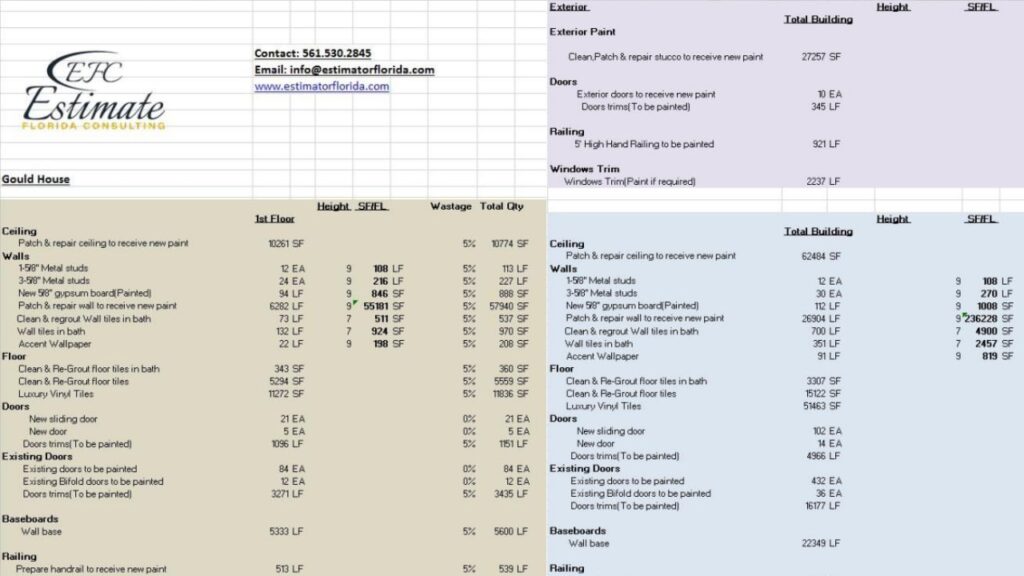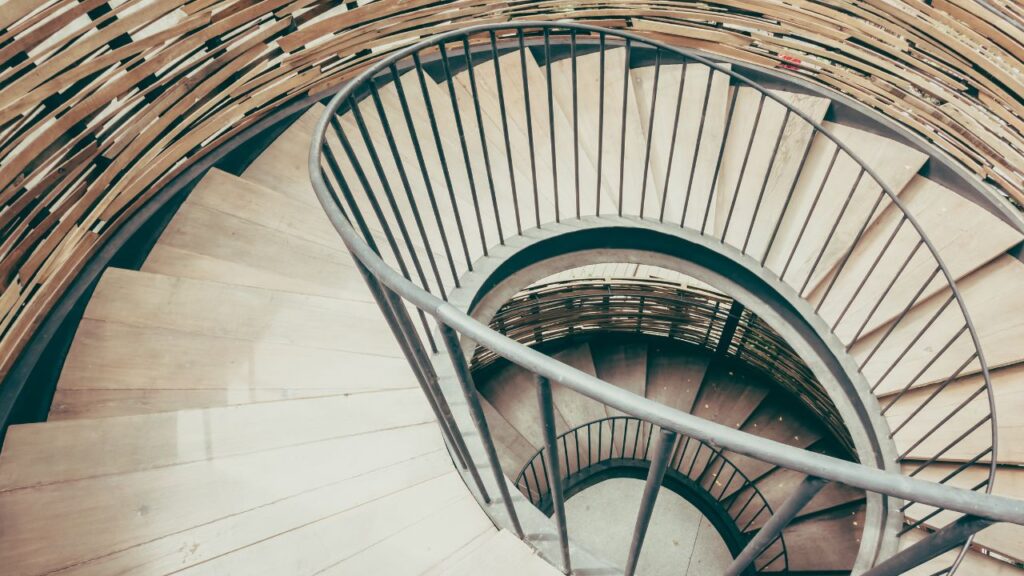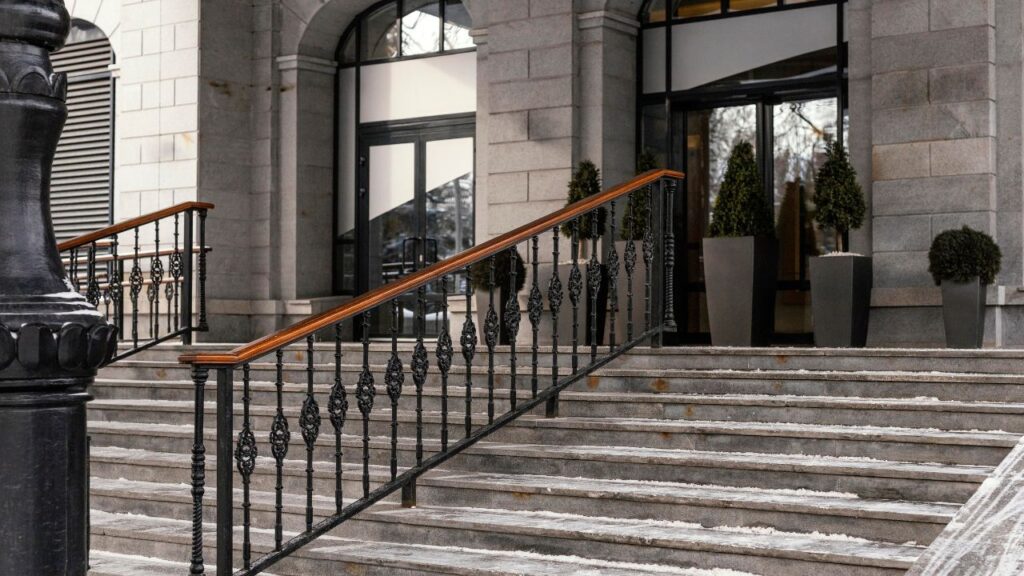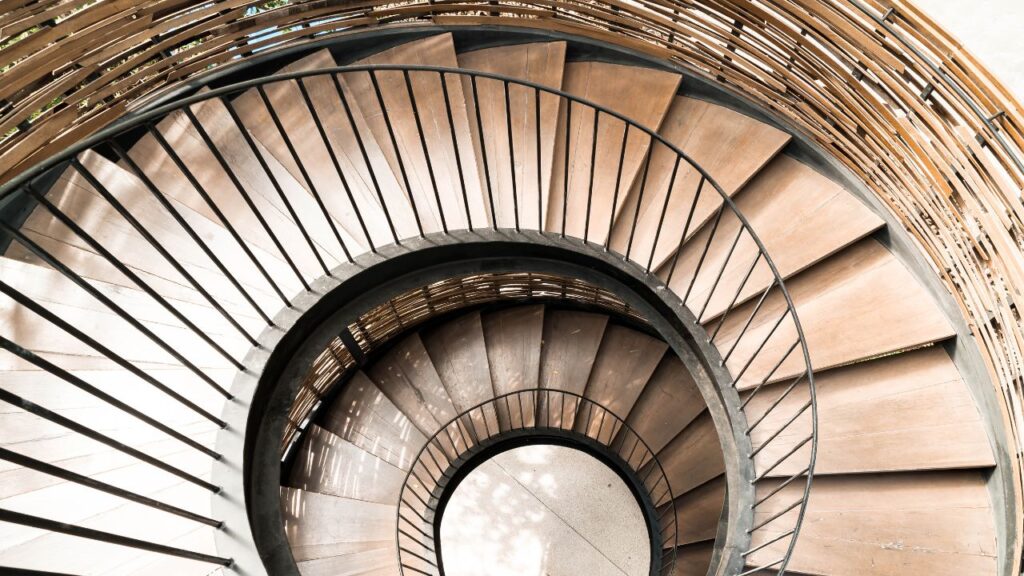A Wining Cost Estimate
That Helps You To Win More Construction Projects

Staircase railings and balusters are important for safety and style in homes. Building codes often require them to prevent accidents. Homeowners who want to install or repair them must understand how they work together.
These elements can do more than just provide safety. For instance, they can add value to a property with their look. They can also show off features like balconies, patios, and landings.

It used to be that only professionals could install stair railings and balusters. But then David found online resources and taught himself. He had to measure carefully and do some steps over. But in the end, he installed beautiful oak stair railings and saved thousands of dollars.
If you’re stressing out about stair railings and balusters, remember: it’s not like you’re picking which limb to take off!

Staircase railings and balusters come in various types, and each type has its unique design and materials. Understanding the different types is essential when estimating the price of installing staircase railings and balusters.
To help you understand the types of staircase railings and balusters, we have created a table below, detailing each type and its features.
Type of Staircase Railings and Balusters | Materials Used | Features |
|---|---|---|
Wood | Wood such as oak, maple, or cherry | Traditional, elegant, and timeless |
Metal | Iron, steel, or aluminum | Modern, sleek, and durable |
Glass | Tempered or laminated glass | Contemporary, minimalist, and transparent |
It’s worth noting that there are also combinations of the above types, such as metal and wood or wood and glass. These combinations offer a unique design and can increase the price of installation.
When deciding which type of stair railing and baluster to install, consider the design, safety, and durability.
For example, a client once wanted a modern-looking staircase for their new home, but they were concerned about the safety of a glass railing. Our team recommended a laminated glass railing, which is stronger and safer than tempered glass. The client was pleased with the result, and the laminated glass also added a unique touch to the overall design.
In summary, understanding the types and features of staircase railings and balusters is crucial when estimating the price of installation. By considering the design, safety, and durability, you can select the right type of railing and baluster for your project.

Don’t skimp on quality for your railing and baluster materials – unless you want your staircase to look like a Pinterest fail.
Staircase railings and balusters can be made from various materials, each possessing unique characteristics. To help compare them, we have compiled a list of popular materials, along with their respective features.
When selecting materials, consider the environmental impact and how it fits the existing décor. For many, staircases hold sentimental value. Recently, a client insisted on keeping the original wooden railing of a family home, even though it was outdated. After restoring it, she was delighted to see a familiar item in a new light. Transform your staircase into a stunning masterpiece with these design options for railings and balusters.
We help contractors find new customers with high-converting websites and locally targeted niche-specific lead-generation programs. You’ll never need to worry about running out of work again! We focus on quality over quantity with our leads for contractors.

Staircases are important in homes. There are many design options to choose from when it comes to railings and balusters.
Table 1 has options like wood, iron, glass, and stainless steel.
Material Options |
|---|
Wood |
Iron |
Glass |
Stainless Steel |
On top of material and style, think about construction type, shape, spacing, thickness, length, color, and finish. Pick these details based on your preference for the best look.
Safety is a must. Regulations for railing height, opening size between balusters/spindles, and no loose parts must be met. If you want a nice-looking staircase, be ready to pay up!
The expense of setting up staircase railings and balusters is determined by various factors that affect the overall cost.
Factors impacting the cost of installing staircase railings and balusters are shown in the table below. The table includes columns for each factor such as material, labor, and location. The prices provided are based on averages and subject to change based on individual circumstances.
Factors | Average Cost |
|---|---|
Material | $900 – $4,500 |
Labor | $500 – $1,500 |
Location | $500 – $2,000 |

Apart from the factors mentioned above, several other variables impact the cost of putting up staircase railings and balusters. These may include the style of railing, the complexity of the installation, and additional features such as lighting or custom designs.
Pro Tip: Consider the long-term costs of the materials used for the installation as investing in quality materials can save money in the future.
Staircase railings: the only time you want something to be a bit of a drag.
Staircase railing and baluster costs depend on the chosen Type of Material. Its cost, durability, aesthetic value, and safety are all affected by this choice.
When selecting a Type of Material for staircase railings and balusters, consider its unique characteristics. Research which type best suits your project needs to get the most out of your investment.
Making the right decision on which material to select for your staircase may seem daunting. But, with the right amount of research, you can ensure a beautiful finished product while staying within budget.
Don’t miss out on creating a stunning staircase that adds value to your home. Invest in high-quality materials that improve both its functionality and aesthetics, while also providing safety. Choose wisely to get maximum satisfaction with your investment. Who knew picking the best material for a flight of stairs could be more complicated than a relationship status on Facebook?

Design intricacy is a major factor when it comes to the cost of installing handrails and balusters. The more complex the design, the pricier the materials and labor. It takes more time to install these designs due to extra measurements and customizing needed for proper fit.
It’s obvious that intricate designs are hard to install, requiring skill from pros, and thus costing more. Unique design requests add complexity, needing modifications or complete overhauls. Factors like curves, angles, and materials influence the expense too.
The demand for attention increases with personalized preferences; for instance, some styles need detailed work on each piece for an attractive finish. Customizations can be both time-consuming and expensive.
In the past, handrails only had safety value and no ornamentation. The Industrial Revolution saw decorative elements gain importance and architects started adding details like complex patterns to railings and facades. This allowed faster rates of architectural enhancements through metalworking technology.
Labour expenses for installing stairway railings and balusters can vary. This includes the time and skill of workers, like prepping the site, installing railings & balusters, cleaning up, etc.
A table for labour costs should include:
The hourly rate changes by location. Cities are usually more expensive than rural areas due to higher living costs. The estimated time taken for installation depends on railing height, baluster spacing, handrail type, etc.
Also, some contractors may charge extra fees for custom end posts or decorative finials.
Remember, this is just an estimate. Prices can differ based on local labour laws and regulations. Home Advisor’s estimator tool

says homeowners pay an average of $2,000, with a range between $700-$4,600. Get ready to save on stairway costs!
To professionally estimate the cost of installing staircase railings and balusters, follow these four steps:
It’s important to note that unique details such as the number of floors and the design complexity of the railings and balusters may require additional costs that should be factored into the estimate.
Don’t miss out on ensuring the safety of your staircase by neglecting to install railings and balusters. Estimating the cost may seem daunting, but with the above steps, it can be done with ease. Take action now to request quotes and get started on your project.
Warning: Measuring your staircase may result in the shocking realization that you’re not as tall as you thought you were.
Maximize your construction business’s potential with our competitive financing options

To know the amount of staircase railing and baluster needed, gauging the full length of the stairway is essential. Here’s what to do:
Be careful when measuring. Overestimation can be costly.
Get professional contractors to take official measurements for accuracy.
Don’t forget to calculate the right number for a successful stair railing project.
Determining how many balusters you need for a staircase railing is essential for estimating costs. You must factor in spacing, height and regulations when calculating the amount. Here are some unique details to be aware of.
Check out building codes to make sure you comply with safety standards and local laws. For example, in homes, the spaces between balusters must be less than four inches. In commercial settings, the rules are stricter and the gap between balusters is specified.
See the table below for the minimum number of balusters per tread length depending on width and code regulations.
Width | 4″ Gap | 3-1/2″ Gap |
|---|---|---|
36″ | 2 | 3 |
42″ | 2 | 4 |
48″ | 3 | 4 |
By considering these factors, your project will meet legal requirements and suit the look you want. Did you know that balusters used to be called spindles? However, now spindles only refer to wooden supports for chairs.
You have the option of buying fancy iron or cheaper aluminum – but don’t use dental floss as a replacement!

Selecting the right material for railings and balusters requires considering several factors. Prices vary based on type and quality. Here’s a summary of common materials with average prices per linear foot:
Material | Average price (per linear foot) |
|---|---|
Wood | $26 – $35 |
Metal | $50 – $120 |
Glass | $200 – $300 |
Wood may need regular upkeep, which adds to the cost. Factor in any additional peripherals like screws, glue, and finishing if necessary.
Pro Tip: Choose quality material. It not only boosts durability, but it could increase your home’s resale value.
Getting quotes from contractors is like online dating for your staircase. It takes time, effort, and some swiping left and right.
Research potential contractors in your area for the best deal on staircase railings and balusters. Get multiple quotes to compare prices. Give detailed info about the project – materials needed, etc. Ask about experience with similar projects.
Price matters but not solely. Quality of work, timeline, and communication are all important. Keep an eye out for unexpected costs too, like modifications before railings can be installed.
One homeowner in our neighborhood went for the cheapest quote. They didn’t get quality work, so had to pay more to redo it. Don’t forget, you get what you pay for!
For those looking to reduce the expenses involved in installing stair railings and balusters, there are some helpful strategies that can be put into practice.
To minimize the cost of installing stair railings and balusters, it is recommended to opt for DIY installations, shop around for the best prices, and consider using alternative materials.

It is important to note that choosing the cheapest options available may not always be the best long-term solution as cheaper materials may require frequent maintenance or replacement, leading to further expenses.
According to historical records, railings and balusters were initially created to prevent people from falling off staircases. Over time, they evolved to become decorative features, with craftsmen showcasing their skills by creating intricate designs and details.
If you’re feeling handy, DIY options for stair railings and balusters can give you the satisfaction of a job well done…and a few extra Band-Aids.
DIY-ing your staircase railings and balusters can save you a lot of money. Pre-assembled kits are available, or you can purchase individual parts and assemble them yourself for more customization.
Research different materials like wood, metal, or vinyl – which vary in price and durability. Working with detailed plans will make installation easier.
To reduce costs further, try second-hand materials or upcycle old fences or gates – both are eco-friendly and can save you money.
Safety is always key. Follow the right procedures, use the right tools, and give yourself plenty of time. With these tips, anyone can install staircase railings and balusters while keeping costs low. Don’t forget to switch to aluminum balusters – they’re cheaper than gold-plated ones!

When considering cost-cutting when installing stair railings and balusters, using cheaper materials is key!
Plus, waiting for sales or discounts can save even more. Don’t pass up the chance to save money by using affordable materials. The right choices will give you a beautiful finished product with more money in your wallet!
To save money installing staircase railings and balusters, opt for a minimalist design! Fewer balusters and wider gaps between them is an option. Basic shapes are more efficient to cut and fit together than ornamental curves. Stick to one material type, like wood or metal. Complex designs require more effort and money. Reducing complexity can save money and still look great! Use these tips and get a stylish staircase in your home without breaking the bank. But remember, installing railings and balusters needs skill and precision – so it’s best to consult an expert if unsure. Don’t let the cost of your own home require a second mortgage!
To work out the cost of adding staircase railings and balusters, accurate estimates are needed. A rough calculation can help plan the budget for this home improvement project.
The following table shows an estimated cost range for installing staircase railings and balusters. The costs may change based on factors like material, design, and labor charges.
Type of railing | Cost per linear foot |
|---|---|
Wood | $20 – $50 |
Metal | $60 – $200 |
Glass | $300 – $650 |
Apart from the material used in the railing, other things also influence the overall cost. These include the installation process, location of stairs, style preferences, permits required by local authorities, and extra features. One unique detail to keep in mind is that a simple straight railing system installation could be less pricey compared to complex or curved designs.
It’s noteworthy that before 2010, staircases only had one handrail installed along one side. Post that year, building codes changed requiring a handrail on both sides of all staircases. This led to an increase in installation costs for staircases with two handrails.
The average cost of installing staircase railings and balusters varies depending on the materials used, the complexity of the project, and the location. However, you can expect to pay between $50 and $150 per linear foot.
The most common materials used for staircase railings and balusters are wood, metal, glass, and cable. Wood is the most traditional and affordable option, while metal and glass are more modern and higher-end options. Cable railings are a popular choice for contemporary designs.
To measure the length of the staircase railing, you need to measure the distance between the newel posts or the wall and the first or last post. For the balusters, you need to measure the distance between the top and bottom rails and divide it by the desired spacing between each baluster.
It is possible to install staircase railings and balusters yourself if you have the necessary skills, tools, and knowledge. However, it is recommended to hire a professional contractor for a safe and proper installation.
The duration of the project depends on the size and complexity of the staircase, the materials used, and the availability of the contractor. Typically, a simple staircase railing installation takes one to two days, while a more elaborate design can take up to a week.
Yes, there are safety codes and regulations that must be followed when installing staircase railings and balusters. The requirements relate to the height, spacing, and strength of the railing and balusters. It is important to check with your local building codes and hire a licensed contractor who is familiar with the regulations.
Here I am going to share some steps to get your construction cost estimate report.
You can send us your plan on info@estimatorflorida.com
Before starting your project, we send you a quote for your service. That quote will have detailed information about your project. Here you will get information about the size, difficulty, complexity and bid date when determining pricing.
We do construction cost estimating and prepare a detailed report for your project. At last, you finalize the report and finish the project.
561-530-2845
info@estimatorflorida.com
Address
5245 Wiles Rd Apt 3-102 St. Pete Beach, FL 33073 United States
561-530-2845
info@estimatorflorida.com
Address
5245 Wiles Rd Apt 3-102 St. Pete Beach, FL 33073 United States
All copyright © Reserved | Designed By V Marketing Media | Disclaimer
IMPORTANT: Make sure the email and cell phone number you enter are correct. We will email and text you a link to get started.
By clicking “I Agree” above you give Estimate Florida Consultin express written consent to deliver or cause to be delivered calls and messages to you by email, telephone, pre-recorded message, autodialer, and text. Message and data rates may apply. You are able to opt-out at any time. You can text STOP to cancel future text messages.